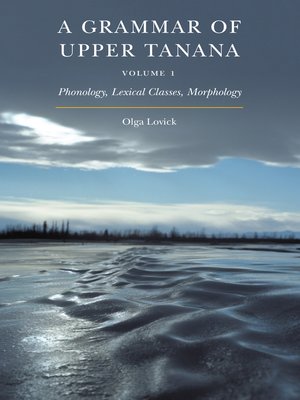
Sign up to save your library
With an OverDrive account, you can save your favorite libraries for at-a-glance information about availability. Find out more about OverDrive accounts.
Find this title in Libby, the library reading app by OverDrive.



Search for a digital library with this title
Title found at these libraries:
| Library Name | Distance |
|---|---|
| Loading... |
A Grammar of Upper Tanana, Volume 1 provides a linguistically accurate written record of the endangered Upper Tanana language. Serving as a descriptive grammar of Upper Tanana, the book meticulously details a language that is currently fluently spoken by approximately fifty people in limited parts of Alaska's eastern interior and Canada's Yukon Territory. As part of the Dene (Athabascan) language group, Upper Tanana embodies elements of both the Alaskan and Canadian subgroups of Northern Dene. This is the first comprehensive grammatical description of any of the Alaskan Dene languages.
With the goal of preserving a language no longer consistently taught to younger generations, Olga Lovick's foundational study is framed within the traditional form of linguistic theory that allows linguists and nonspecialists alike to study a vulnerable language that exists outside the dominant Indo-European mainstream. This text provides a substantive bulwark to protect a language acutely threatened by near-term extinction. In its expansive detailing of the Upper Tanana language, this volume is methodologically oriented toward structural linguistics through approaches focusing on phonology, lexical classes, and morphology. With attention to both detail and thoroughness, Lovick's comparative approach provides solid grounding for the future survival of the Upper Tanana language.
With the goal of preserving a language no longer consistently taught to younger generations, Olga Lovick's foundational study is framed within the traditional form of linguistic theory that allows linguists and nonspecialists alike to study a vulnerable language that exists outside the dominant Indo-European mainstream. This text provides a substantive bulwark to protect a language acutely threatened by near-term extinction. In its expansive detailing of the Upper Tanana language, this volume is methodologically oriented toward structural linguistics through approaches focusing on phonology, lexical classes, and morphology. With attention to both detail and thoroughness, Lovick's comparative approach provides solid grounding for the future survival of the Upper Tanana language.







